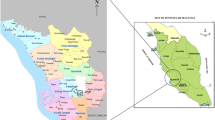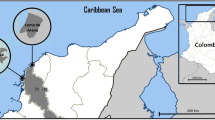Abstract
Even though a growing number of reports indicated favorable health effects with fish consumption, kinds of hazardous substances in fish were detected in fish and to be exceeded advisory limitation. Benefit–risk assessment of commonly consumed fish is urgently needed. We conducted fish consumption survey and fish sampling in the coast of South China Sea to assess benefit–risk effect of commonly consumed fish species. For local residents, weekly methyl mercury (MeHg) exposures from commonly consumed fish species ranged from 0.12 to 2.11 μg/kg bw. Apart from Muraenesox cinereus and Acanthopagrus latus, the rest of 92% (23/25) fish species were at low risk of MeHg exposure. Daily docosahexaenoic acid intakes via consuming specific fish were between 42.18 and 1687.04 mg/day. A total of 72% (18/25) fish species could provide 200 mg/day of DNA for local residents. Benefit–risk assessment assuming intelligence quotient (IQ) score model showed net IQ point gains between 1.53 and 5.65 points with consuming various fish species, indicative of large distinction of health benefit from various fish species. This study suggests commonly consumed fish species from China South Sea could bring much more positive effect than negative effect. Species-specific fish should be considered when providing recommendations of fish consumption. Muraenesox cinereus and Acanthopagrus latus should be minded with risk of MeHg exposure in taking large amounts.




Similar content being viewed by others
Abbreviations
- MeHg:
-
Methyl mercury
- DHA:
-
Docosahexaenoic acid
- IQ:
-
Intelligence quotient
- PUFA:
-
Polyunsaturated fatty acids
- FAO/WHO:
-
Food and Agriculture Organization of the United Nations and WHO
- JECFA:
-
The Joint United Nations FAO/WHO Expert Committee on Food Additives
- HQ:
-
Hazard quotient
- PTWI:
-
Provisional tolerable weekly intake
- DI:
-
Desirable dose index
- OWI:
-
Weekly optimal intake
References
Bocking, C., Nockher, W. A., Schreiner, M., Renz, H., & Pfefferle, P. I. (2010). Development and validation of a combined method for the biomonitoring of omega-3/-6 fatty acids and conjugated linoleic acids in different matrices from human and nutritional sources. Clinical Chemistry and Laboratory Medicine, 48(12), 1757–1763.
Calder, P. C. (2012). Mechanisms of action of (n-3) fatty acids. Journal of Nutrition, 142(3), 592S–599S.
Chang, L. F., Jiang, S. J., & Sahayam, A. C. (2007). Speciation analysis of mercury and lead in fish samples using liquid chromatography–inductively coupled plasma mass spectrometry. Journal of Chromatography A, 1176, 143–148.
Chen, H. T., Chen, J. G., Jin, X. Z., & Wei, D. Y. (2009). Determination of trace mercury species by high performance liquid chromatography–inductively coupled plasma mass spectrometry after cloud point extraction. Journal of Hazardous Materials, 172(2), 1282–1287.
Chowdhury, R., Stevens, S., Gorman, D., Pan, A., Warnakula, S., Chowdhury, S., et al. (2012). Association between fish consumption, long chain omega 3 fatty acids, and risk of cerebrovascular disease: Systematic review and meta-analysis. BMJ, 345, e6698.
Chung, S. W., Kwong, K. P., Tang, A. S., Xiao, Y., & Ho, P. Y. (2008). Mercury and methyl mercury levels in the main traded fish species in Hong Kong. Food Additives & Contaminants: Part B Surveillance, 1(2), 106–113.
Du, Z. Y., Zhang, J., Wang, C., Li, L., Man, Q., Lundebye, A. K., et al. (2012). Risk–benefit evaluation of fish from Chinese markets: nutrients and contaminants in 24 fish species from five big cities and related assessment for human health. Science of the Total Environment, 416, 187–199.
FAO/WHO. (2009). Fats and fatty acids in human nutrition. Proceedings of the Joint FAO/WHO Expert Consultation. November 10–14, 2008. Geneva, Switzerland. Annals of Nutrition and Metabolism, 55(1–3), 5–300.
FAO/WHO. (2011). Report of the joint FAO/WHO expert consultation on the risks and benefits of fish consumption. Rome: Food and Agriculture Organization of the United Nations.
Friberg, L. M. N., & Mottet, N. K. (1989). Accumulation of methyl mercury and inorganic mercury in the brain. Biological Trace Element Research, 21(1), 201–206.
Friesen, R. W., & Innis, S. M. (2009). Dietary arachidonic acid to EPA and DHA balance is increased among Canadian pregnant women with low fish intake. Journal of Nutrition, 139(12), 2344–2350.
Gao, Y. X., Zhang, H., Yu, X., He, J. L., Shang, X., Li, X., et al. (2014). Risk and benefit assessment of potential neurodevelopmental effect resulting from consumption of marine fish from a coastal archipelago in China. Journal of Food and Chemistry, 62(22), 5207–5213.
Gil, A., & Gil, F. (2015). Fish, a Mediterranean source of n-3 PUFA: Benefits do not justify limiting consumption. British Journal of Nutrition, 113(S2), S58–S67.
Hsi, H. C., Hsu, Y. W., Chang, T. C., & Chien, L. C. (2016). Methyl mercury concentration in fish and risk–benefit assessment of fish intake among pregnant versus infertile women in Taiwan. PLoS ONE, 11(5), e155704.
Khawaja, O. A., Gaziano, J. M., & Djousse, L. (2014). N-3 fatty acids for prevention of cardiovascular disease. Current Atherosclerosis Reports, 16(11), 450.
Kim, S. J., Lee, H. K., Badejo, A. C., Lee, W. C., & Moon, H. B. (2016). Species-specific accumulation of methyl and total mercury in sharks from offshore and coastal waters of Korea. Marine Pollution Bulletin, 102(1), 210–215.
Lee, S., Roh, Y., & Kim, K. W. (2018). Influence of chloride ions on the reduction of mercury species in the presence of dissolved organic matter. Environmental Geochemistry and Health. https://doi.org/10.1007/s10653-018-0121-0.
Liu, J. L., Xu, X. R., Yu, S., Cheng, H., Peng, J. X., Hong, Y. G., et al. (2014). Mercury contamination in fish and human hair from Hainan Island, South China Sea: Implication for human exposure. Environmental Research, 135, 42–47.
Malik, R. N., Hashmi, M. Z., & Huma, Y. (2014). Heavy metal accumulation in edible fish species from Rawal Lake Reservoir, Pakistan. Environmental Science and Pollution Research, 21(2), 1188–1196.
Marrugo-Negrete, J., Verbel, J. O., Ceballos, E. L., & Benitez, L. N. (2008). Total mercury and methyl mercury concentrations in fish from the Mojana region of Colombia. Environmental Geochemistry and Health, 30(1), 21–30.
Miniero, R., Beccaloni, E., Carere, M., Ubaldi, A., Mancini, L., Marchegiani, S., et al. (2013). Mercury (Hg) and methyl mercury (MeHg) concentrations in fish from the coastal lagoon of Orbetello, central Italy. Marine Pollution Bulletin, 76(1–2), 365–369.
Myers, G. J., Davidson, P. W., & Strain, J. J. (2007). Nutrient and methyl mercury exposure from consuming fish. Journal of Nutrition, 137(12), 2805–2808.
Neff, M. R., Bhavsar, S. P., Ni, F. J., Carpenter, D. O., Drouillard, K., Fisk, A. T., et al. (2014). Risk–benefit of consuming Lake Erie fish. Environmental Research, 134, 57–65.
Qiu, Y. W., & Wang, W. X. (2016). Comparison of mercury bioaccumulation between wild and mariculture food chains from a subtropical bay of Southern China. Environmental Geochemistry and Health, 38(1), 39–49.
Rodríguez-Reino, M. P., Rodríguez-Fernández, R., Peña-Vázquez, E., Domínguez-González, R., Bermejo-Barrera, P., & Moreda-Piñeiro, A. (2015). Mercury speciation in seawater by liquid chromatography–inductively coupled plasma-mass spectrometry following solid phase extraction pre-concentration by using an ionic imprinted polymer based on methyl-mercury–phenobarbital interaction. Journal of Chromatography A, 1391, 7–9.
SAC. (2012). Maximum levels of contaminants in foods. GB 2762-2012. Beijing: Standardization Administration of China.
Sadhu, A. K., Kim, J. P., Furrell, H., & Bostock, B. (2015). Methyl mercury concentrations in edible fish and shellfish from Dunedin, and other regions around the South Island, New Zealand. Marine Pollution Bulletin, 101(1), 386–390.
Sagiv, S. K., Thurston, S. W., Bellinger, D. C., Amarasiriwardena, C., & Korrick, S. A. (2012). Prenatal exposure to mercury and fish consumption during pregnancy and attention-deficit/hyperactivity disorder-related behavior in children. Archives of Pediatrics and Adolescent Medicine, 166(12), 1123–1131.
Shaikh, S. R., Kinnun, J. J., Leng, X., Williams, J. A., & Wassall, S. R. (2015). How polyunsaturated fatty acids modify molecular organization in membranes: insight from NMR studies of model systems. Biochimica et Biophysica Acta, 1848(1), 211–219.
Souza-Araujo, J., Giarrizzo, T., Lima, M. O., & Souza, M. B. (2016). Mercury and methyl mercury in fishes from Bacaja River (Brazilian Amazon): Evidence for bioaccumulation and biomagnification. Journal of Fish Biology, 89(1), 249–263.
Starling, P., Charlton, K., McMahon, A. T., & Lucas, C. (2015). Fish intake during pregnancy and foetal neurodevelopment: A systematic review of the evidence. Nutrients, 7(3), 2001–2014.
Sunderland, E. M., Li, M. L., & Bullard, K. (2018). Decadal changes in the edible supply of seafood and methyl mercury exposure in the United States. Environmental Health Perspectives, 126(1), 017006.
Tao, H. C., Zhao, K. Y., Ding, W. Y., Li, J. B., Liang, P., Wu, S. C., et al. (2016). The level of mercury contamination in mariculture sites at the estuary of Pearl River and the potential health risk. Environmental Pollution, 219, 829–836.
The Chinese Nutrition Society. (2016). The food guide Pagoda for Chinese residents. http://dg.cnsoc.org/upload/images/source/20160519163856103.jpg. Accessed September, 2018 (in Chinese).
Turyk, M. E., Bhavsar, S. P., Bowerman, W., Boysen, E., Clark, M., Diamond, M., et al. (2012). Risks and benefits of consumption of Great Lakes fish. Environmental Health Perspectives, 120(1), 11–18.
US FAO. (2017). Fish production. http://www.fao.org/figis/servlet/SQServlet?file=/work/FIGIS/prod/webapps/figis/temp/hqp_3209185666439813404.xml&outtype=html. Accessed July, 2017.
Valentine, R. C., & Valentine, D. L. (2004). Omega-3 fatty acids in cellular membranes: A unified concept. Progress in Lipid Research, 43(5), 383–402.
Wall, R., Ross, R. P., Fitzgerald, G. F., & Stanton, C. (2010). Fatty acids from fish: the anti-inflammatory potential of long-chain omega-3 fatty acids. Nutrition Reviews, 68(5), 280–289.
Wenstrom, K. D. (2014). The FDA’s new advice on fish: It’s complicated. American Journal of Obstetrics and Gynecology, 211(5), 475–478.
Acknowledgements
The study was supported by Natural Science Foundation of Guangdong Province, China (Grant Nos. 2018A030323230 and 2018A030313913). We thank Gui-yuan Ji, Qi Jiang, Yan-jun Tang and Zhong-jun Dun from Guangdong Provincial Institute of Public Health, Guangdong Provincial Center for Disease Control and Prevention for excellent support during the field work. We thank Xi-mei Wu, Shu-guang Hu, Jing Wang and Zu-jian Su from Guangdong Provincial Center for Disease Control and Prevention for their supports in sample analysis.
Author information
Authors and Affiliations
Corresponding authors
Additional information
Publisher's Note
Springer Nature remains neutral with regard to jurisdictional claims in published maps and institutional affiliations.
Electronic supplementary material
Below is the link to the electronic supplementary material.
Rights and permissions
About this article
Cite this article
Wang, P., Chen, Sw., Chen, Zh. et al. Benefit–risk assessment of commonly consumed fish species from South China Sea based on methyl mercury and DHA. Environ Geochem Health 41, 2055–2066 (2019). https://doi.org/10.1007/s10653-019-00254-1
Received:
Accepted:
Published:
Issue Date:
DOI: https://doi.org/10.1007/s10653-019-00254-1




